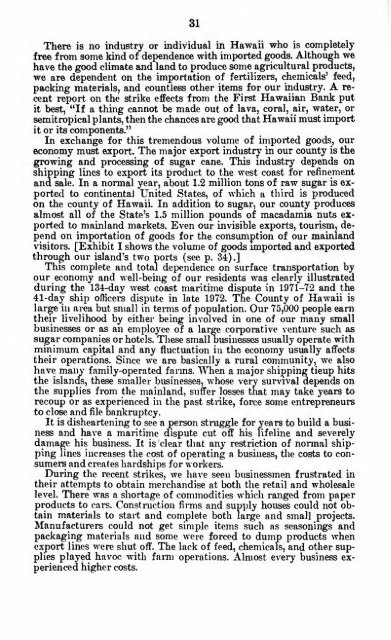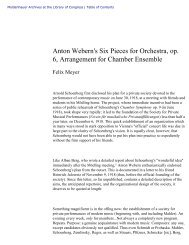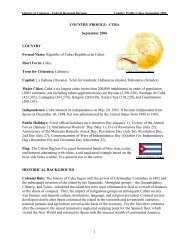1 - American Memory
1 - American Memory
1 - American Memory
You also want an ePaper? Increase the reach of your titles
YUMPU automatically turns print PDFs into web optimized ePapers that Google loves.
31<br />
There is no industry or individual in Hawaii who is completely<br />
free from some kind of dependence with imported goods. Although we<br />
have the good climate and land to produce some agricultural products,<br />
we are dependent on the importation of fertilizers, chemicals' feed,<br />
packing materials, and countless other items for our industry. A re-<br />
cent report on the strike effects from the First Hawaiian Bank put<br />
it best, "If a thing cannot be made out of lava, coral, air, water, or<br />
semitropical plants, then the chances are good that Hawaii must import<br />
it or its components."<br />
In excliange for this tremendous volume of imported goods, our<br />
economy must export. The major export industry in our county is the<br />
growing and processing of sugar cane. This industry depends on<br />
shipping lines to export its product to the west coast for refinement<br />
and sale. In a normal year, about 1.2 million tons of raw sugar is ex-<br />
ported to continental United States, of which a third is produced<br />
on the county of Hawaii. In addition to sugar, our county produces<br />
almost all of the State's 1.5 million pounds of macadamia nuts ex-<br />
ported to mainland markets. Even our invisible exports, tourism, de-<br />
pend on importation of goods for the consumption of our mainland<br />
visitors. [Exhibit I shows the volume of goods imported and exported<br />
through our island's two ports (see p. 34).]<br />
This complete and total dependence on surface transportation by<br />
our economy and well-being of our residents was clearly illustrated<br />
during the 134-day west coast maritime dispute in 1971-72 and the<br />
41-day ship ofticei-s dispute in late 1972. The County of Hawaii is<br />
large in area but small in terms of population. Our 75,000 people earn<br />
their livelihood by either being involved in one of our many small<br />
businesses or as an employee of a large corporative venture such as<br />
sugar companies or hotels. These small Dusinesses usually operate with<br />
minimum capital and any fluctuation in the economy usually affects<br />
their operations. Since we are basically a rural community, we also<br />
have many family-operated farms. ^\lien a major shipping tieup hits<br />
the islancfs, these smaller businesses, whose very survival depends on<br />
the supplies from the mainland, suffer losses that may take years to<br />
recoup or as experienced in the past strike, force some entrepreneurs<br />
to close and file bankruptcy.<br />
It is disheartening to see a person struggle for years to build a busi-<br />
ness and have a maritime dispute cut off his lifeline and severely<br />
damage his business. It is clear that any restriction of normal ship-<br />
ping lines increases the cost of operating a business, the costs to con-<br />
sumers and creates hardships for workers.<br />
During the recent strikes, we have seen businessmen frustrated in<br />
their attempts to obtain merchandise at both the retail and wholesale<br />
level. There was a shortage of commodities which ranged from paper<br />
products to cars. Construction firms and supply houses could not ob-<br />
tain materials to start and complete both large and small projects.<br />
Manufacturers could not get simple items such as seasonings and<br />
packaging materials and some were forced to dump products when<br />
export lines were shut off. The lack of feed, chemicals, and other sup-<br />
plies played havoc with farm operations. Almost every business ex-<br />
perienced higher costs.



![Albert Einstein Papers [finding aid]. Library of Congress. [PDF ...](https://img.yumpu.com/21604228/1/190x245/albert-einstein-papers-finding-aid-library-of-congress-pdf-.jpg?quality=85)





![American Colony in Jerusalem Collection [finding aid]. Library of ...](https://img.yumpu.com/17941275/1/190x245/american-colony-in-jerusalem-collection-finding-aid-library-of-.jpg?quality=85)



![Piccard Family Papers [finding aid]. - American Memory - Library of ...](https://img.yumpu.com/17941234/1/190x245/piccard-family-papers-finding-aid-american-memory-library-of-.jpg?quality=85)


